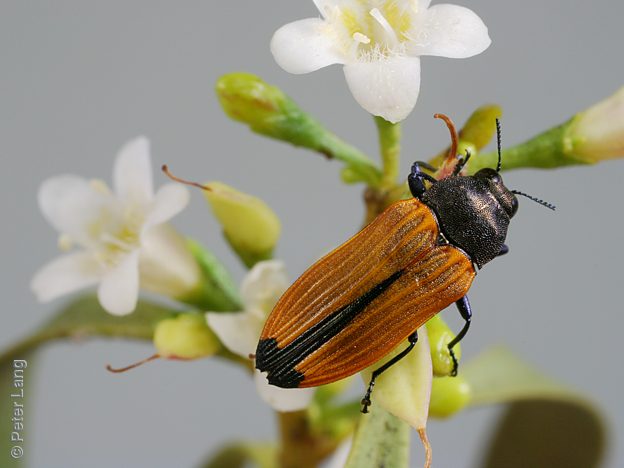
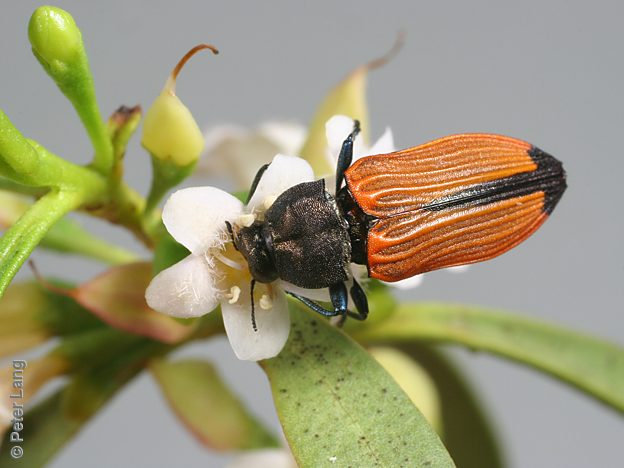
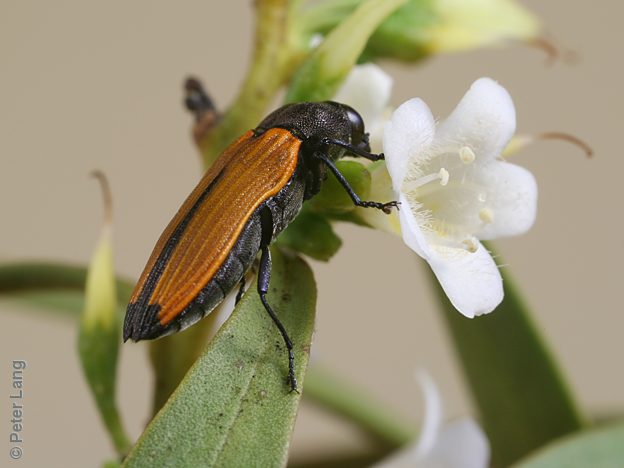
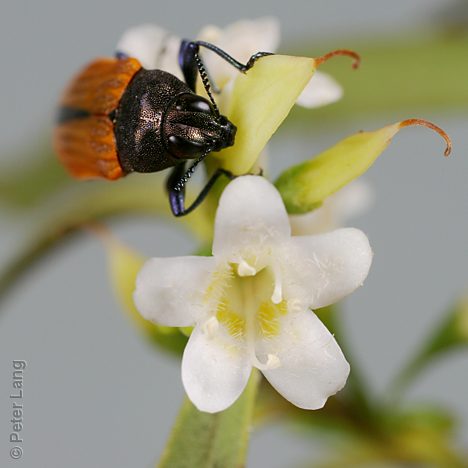
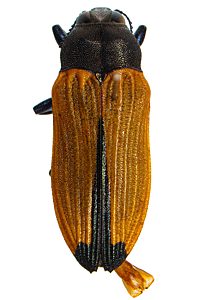
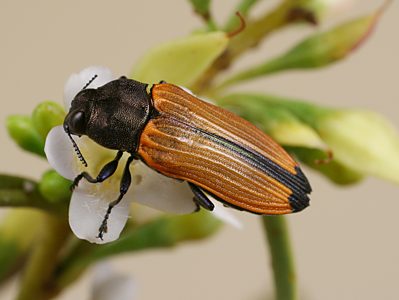
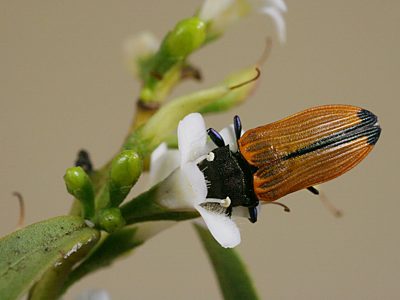
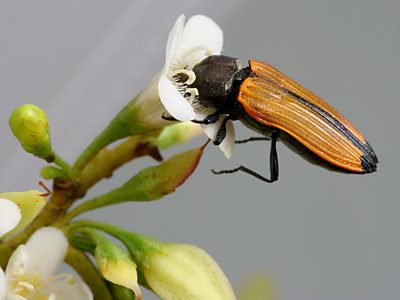
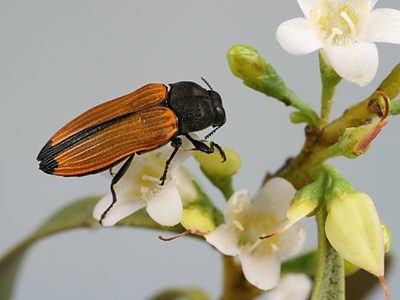
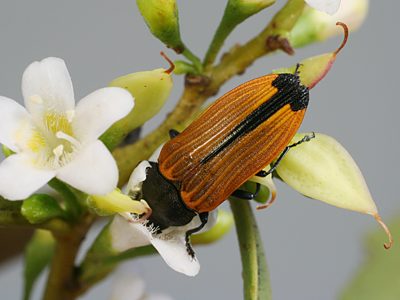
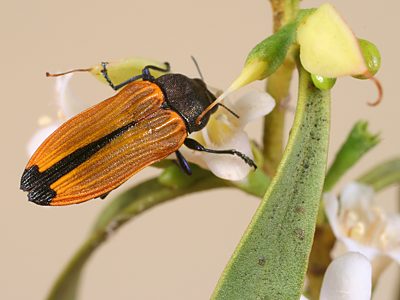
, EP, H1_x300.jpg)
size¹:
×
3.7 mm











, EP, H1_x300.jpg)
| male | female | |||||
|---|---|---|---|---|---|---|
| L1 | 9.8 | 9.5 – 10.1 | n = 6 | 10.6 | 9.5 – 11.95 | n = 6 |
| L2 | 9.5 | 9.1 – 9.8 | n = 3 | 10.0 | 9.6 – 10.35 | n = 3 |
| W | 3.5 | 3.35 – 3.6 | n = 6 | 3.9 | 3.3 – 4.45 | n = 6 |
| Legend | L1 | length from clypeus/frons to elytral apex (mean, range, sample size) |
| L2 | length from anterior of edge of eyes to elytral apex | |
| W | maximum width with elytra fully closed |
Very different to other members of the C. sexplagiata group but has the characteristic highly reduced tarsal pads and the triangular aedeagus. Mostly black, often with some weak blue reflections, with the elytra strongly ribbed and orange-brown except for a black posterior sutural strip and apex.
Barker {2006a} notes that this was the first Lycid-mimicking species of Castiarina to be described. The model appears to be the very distasteful beetle Porrostoma rhipidium (family Lycidae) which is quite commonly seen in SA on the same whitish nectar-rich flowers that are visited by various Castiarina species. It is illustrated here in the last image above.
The black areas in the posterior three-quarters of the elytra of C. erythroptera resemble the middle and protruding ends of the underlying black wings and abdomen which are exposed by the slightly spreading elytra in the Lycid model. The resemblance to the model is also enhanced by the angling of the thorax and more prominent ribbing of the elytra which are deviations from the standard form in the C. sexplagiata group.
As Buprestids generally contain levels of the bitter compound buprestin, at least some degree of Mulleran mimicry would be operating here, rather than this being a simple case of Batesian mimcry by a benign mimic. Other apparent Lycid mimics amongst SA Castiarina species are: C. amplipennis, C. parallelipennis, C. cf. parallelipennis and C. rufipennis. These represent at least three other Castiarina species groups in which the same syndrome of traits has appeared, but is superimposed on very different underlying morphologies.
| Legend | P.J.Lang collection vouchered records | |
| other private collection or museum specimens, or sightings |
|
|
|
|
|
|
|
|
|
|
|
|
|
||||||||||||||||||||||||||||||||||||||||||||||||
|
|
|
|
|
|
|
|
|
|
|
|
|
||||||||||||||||||||||||||||||||||||||||||||||||
| Jul | Aug | Sep | Oct | Nov | Dec | Jan | Feb | Mar | Apr | May | Jun |
| Legend | ||
9 | number of active beetles, actually recorded in that quarter-month | |
| actual count > 2 (median) | ||
| actual count <= 2 (median) | ||
| beetles | sites | SA regions¹ | family | position on host plant | |||
| Myoporum platycarpum ssp. perbellum | 13 | 2 | EP | S | |||
| Myoporum platycarpum ssp. platycarpum | 13 | 3 | EP, MU | S | |||
| Myoporum platycarpum | 8 | 5 | EP, MU | S | |||
| Eucalyptus gracilis | 4 | 1 | MU | M | |||
| Hysterobaeckea behrii | 3 | 1 | MU | M | |||
| Senna sp. | 2 | 1 | MU | F | |||
| Eucalyptus phenax ssp. phenax | 2 | 1 | EP | M | |||
| Bursaria spinosa ssp. lasiophylla | 1 | 1 | MU | P1 | |||
| Eremophila scoparia | 1 | 1 | MU | S | |||
| Grevillea pterosperma | 1 | 1 | EP | P2 |
| Legend | beetles | count of beetles collected from, or sighted on, host plant taxon |
| sites | count of major sites (unique 10 km grid cells +/- some distinct approximate localities) | |
| Plant names in green are hyperlinked to a matching host species page with plant photos. | ||
| Code | beetles | % | host plant taxa | |
| S | Scrophulariaceae | 35 | 73% | 4 |
| M | Myrtaceae | 9 | 19% | 3 |
| F | Fabaceae | 2 | 4% | 1 |
| P1 | Pittosporaceae | 1 | 2% | 1 |
| P2 | Proteaceae | 1 | 2% | 1 |
| position | beetles | sites | |
| on flower(s) | 29 | 11 | |
| on flowering plant | 17 | 4 | |
| on plant (unspecified) | 2 | 2 |
In SA, adults of this species have mostly been found on flowering Sugarwood Myoporum platycarpum, a plant from the same family (Scrophulariaceae) as the usual host of another SA member of the C. sexplagiata group, C. vanderwoudeae. However, in NSW it has only been recorded on genera from other families, including Rutaceae (Geijera parviflora, (Carter 1934}) and Myrtaceae (Kunzea and/or Leptospermum, Hawkeswood 1978, Webb 1986).
| ¹ Legend | regions | SA State Herbarium regions (map) EA: Eastern, EP: Eyre Peninsula, FR: Flinders Ranges, GT: Gairdner-Torrens, KI: Kangaroo Island, LE: Lake Eyre, MU: Murray, NL: Northern Lofty, NU: Nullarbor, NW: North-Western, SE: South-Eastern, SL: Southern Lofty, YP: Yorke Peninsula |
| size | The ellipse is the correct size when printed, indicative on a desktop screen, and likely to be wrong on a mobile device. |